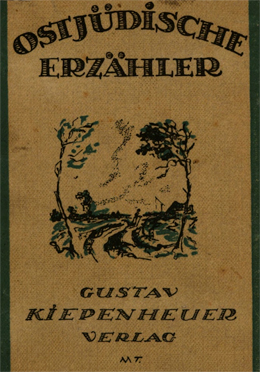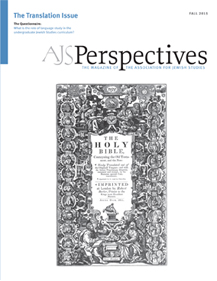![Cover of Sholem Alechem. Die Geschichten Tewjes des Milchhändlers [The Stories of Tevye the Dairyman], German translation by by Alexander Eliasberg (Berlin: Harz, 1921).](http://perspectives.ajsnet.org/wp-content/uploads/Woelk-Eliasberg1955sm.jpg)
In the early twentieth century many German Jewish intellectuals and artists, Scholem among them, became fascinated by their eastern European coreligionists. The East, and with it Yiddish, was perceived as exotic and as "authentic" by "assimilated" German Jews. In this environment, Eliasberg's translations reached large audiences, but were subject to withering criticism for their perceived inability to capture the "local color" of the Yiddish-speaking shtetl, as German Expressionist Alfred Lemm wrote.

Much more surprising than postwar readers' willingness to ignore Scholem and Lemm's criticisms is the fact that Eliasberg had postwar readers at all. Despite the fact that a majority of Eliasberg's readership had either been killed or forced into exile during the Second World War, his books were published in both postwar German states for new generations of German readers. Not only was this readership largely non-Jewish, it also conceived of the divide between the East and West in a radically different way from Eliasberg's prewar readers. While an image of the exotic, Jewish East had once fueled German Jewish interest in Yiddish culture, the postwar world was divided along different lines. No longer were Eliasberg's readers and publishers primarily concerned with a perceived cleft between Eastern and Western Jewry, but instead with the division between the Eastern and Western worlds as defined by Cold War politics. Scholem's interest in how Yiddish could best be translated into German was replaced by concern about how each German state could best position itself politically by celebrating Yiddish literature in a way that furthered that state's own self-image.
The first postwar publication of one of Eliasberg's translations from Yiddish, which was also the first postwar German publication of any work of Yiddish fiction, appeared in 1955, when the East German publishing house Volk und Welt released Eliasberg's translation of the Tevye stories by the most famous of all Yiddish writers, Sholem Aleichem (Shalom Rabinovitz). This was shortly followed by several West German reprintings of Eliasberg's translations from Yiddish, including three distinct collections in the 1960s alone. The forewords and editors' notes that accompanied these translations, along with the reviews of books related to Yiddish from this same time period, reflect an interest in translation that was geared not toward the communication of linguistic nuance in a foreign language but toward the fashioning of this literature into a memorial.
In both East and West Germany, Eliasberg's texts were celebrated as portals into a lost world. No longer were the texts meant to convey the specifics of a Yiddish literary original, but rather to paint, in broad strokes, a comprehensive picture of a world destroyed by the Holocaust. A 1962 West German publication of Eliasberg's translations of stories by the classic Yiddish writers Sholem Aleichem, Y. L. Peretz, and Sholem Yankev Abramovitsh, for example, was accompanied by an introduction reminding readers that literary depictions of eastern European Jewry are "all the more justified" by the fact that this world was destroyed in the Holocaust. A similar collection published in East Germany two years later defines and emphasizes its own importance through an editor's note claiming, "This world has completely disappeared; it is alive only in literature. This volume shows how the people who lived there felt, lived and thought."
East and West Germans conceived of their roles in the revival of this literature in strikingly different ways. West Germans stressed the contemporary suppression of Jewish culture in Eastern Europe and the fostering of this culture by their allies in New York. The standard East German narrative emphasized the continued presence of Yiddish in Eastern Bloc countries and the roles played by the United States and Israel in the decline of Yiddish after the Holocaust. Yiddish literary translations, therefore, became more than memorials to a lost culture. They became emblematic of the way in each German state defined itself against not only the Nazi past, but also against the other.
The German Jewish theorist Walter Benjamin famously wrote that translations give a literary text a type of afterlife. The reframing of the Eliasberg translations of Yiddish literary classics in the postwar era, with its emphasis on memorial and revival, certainly capitalized on this potential. But these particular texts, translations reframed for new environments, also suggest that multiple afterlives are possible. Looking at the history of Eliasberg's translations from Yiddish into German, we see clearly that translations can take on afterlives of their own. The changing significance of these "revivals" had nothing to do with changes to the translation itself, but to the environment in which this literature was introduced and the role these texts then played in the process of identity formation for new audiences.

